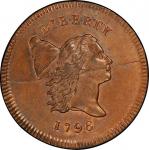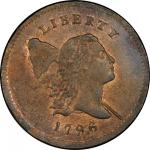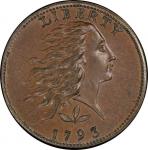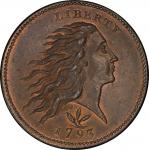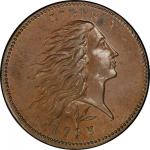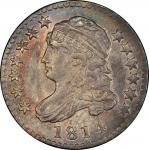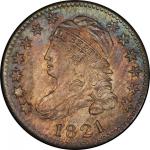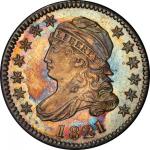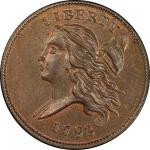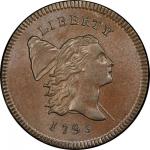“We are about selling at public auction the superb collection of John G. Mills, of Albany, New York, one of the richest collections that has ever been sold of American coins. The edition de Luxe is being published with 14 plates of the greatest rarities and finest specimens, at a charge of $5. Should be glad to have your subscription for copy.” — Henry Chapman to Robert Garrett, March 11, 1904 One of the most amazing Flowing Hair half cents extant, the obverse of this coin is surreally prooflike, fully reflective and boldly lustrous to an extent no other half cent of this era can match. The reverse shows similarly extravagant cartwheel, though on a less reflective surface. The surfaces are perfectly even, toned a rich chocolate brown that resembles the finest bronzed Proofs struck in England in this era. The wide expanse of the obverse fields is pristine, so free of marks that it is difficult to imagine this coin wasn’t already cherished before it left the Mint. The reverse fields are just as immaculate, free of any sort of defect or distraction and enriched by delicate hints of pastel blue-green in the protected regions where mint color faded last. A small and very subtle area of discoloration is mostly hidden in the obverse denticles above 6:00. Liberty’s neck shows a very short scrape, and a nearly invisible diagonal hairline stretches from the corner of her eye to the base of her ear. A very thin hairline is barely visible along the tips of the denticles above F of OF on the reverse, and a light abrasion is similarly close to the tips of the denticles above RT of LIBERTY. The rims are squared and perfectly preserved. Struck from the earliest recorded die state, this coin shows a very fine die crack at the denticle above the tip of the upper left serif of D in UNITED, a crack that eventually expands and connects two, then three, denticles above D. The reverse is not bulged and still shows fine lapping lines among the leaves below TED, above HA of HALF, below C of CENT and M of AMERICA, and connecting O of OF to the leaf below. Another thicker die line, raised on the coin but incuse in the die, nearly connects the top of O to a denticle above its left side. In later states this line disappears while other lines remain bold. A few die pits from spalling, sometimes incorrectly termed die rust, are seen between the leaves just below the open top of the wreath. Recutting is visible on H of HALF, N of CENT, and N of UNITED. Breen suggested the possibility that a coin could exist with “perfect dies, no trace of break in dentils above ED,” but none has ever been recorded. Manley sums up his 1.0, “the usual state,” as any coin early enough to lack a bulge at AME of AMERICA, and takes the presence of the tiny die break in the denticles above D for granted on all known specimens. Flowing Hair half cents are not typically described as prooflike. There are only two pre-1800 half cents to even earn a mention in Walter Breen’s Encyclopedia of United States and Colonial Proof Coins, the clearinghouse for listings of Proofs, reputed Proofs, and possible Proofs. One is the F.C.C. Boyd 1796 With Pole half cent (“extremely doubtful if even the Boyd coin qualifies at this level”) and this is the other, noted by Breen as “the John G. Mills example, so claimed, is untraced.” When Breen first published the book in 1977, and over the two decades that he assembled his Proof notes, this coin was locked away in Evergreen House at the Johns Hopkins University. During Breen’s time at Hopkins as an undergraduate student, he had spent time with the collection, and he had visited it periodically since, but he apparently missed the fact that this famous half cent was hiding in plain sight. In the 1904 Mills sale, the Chapmans recorded that the coin was “Proof” and a “Perfect impression with broad serratures” with “light olive color ... [a] beautiful specimen and extremely rare in this state.” A decade earlier, when cataloging the 1895 Winsor sale, they had called this coin a “superb specimen having a beautiful light olive color with proof surface on obverse ... one of, if not the most beautiful specimen known.” The judgment on whether this is the most beautiful specimen will vary between individuals, but it is clear this ranks among the very finest survivors known of this date. Just four 1795 half cents have been graded MS-66 or finer by PCGS. Two of those are No Pole coins, the most common major variety of the year, namely the D. Brent Pogue 1795 Cohen-6 (MS-66+ BN) and the McGuigan Cohen-5 (MS-66 RB). The McGuigan 1795 Cohen-1 is the only other half cent of the date in this echelon, and the only example of this variety deemed finer; it has been certified as MS-67 BN by PCGS. The provenance of this coin is confirmed as early as the 1895 Chapman brothers sale of the Richard Brown Winsor Collection, but good evidence supports an even longer pedigree chain. This is probably the specimen described in Ebenezer Locke Mason’s October 1870 sale of the William Fewsmith cabinet, offered as lot 1061 and described as “1795: thick planchet; lettered edge; very fine, indeed; beautiful light olive; rare.” It brought $7.25, $1.25 more than the Uncirculated 1797 a few lots later and $1.75 more than the “fine; light olive; rare” 1793 half cent in lot 1055. The sources examined are unclear: an annotated Winsor catalog suggests this is the Fewsmith coin, but lists the wrong lot number, while a priced and named Fewsmith catalog notes other half cents selling to Winsor but not this one. Unfortunately, there is no such creature as a plated Fewsmith catalog. In 1870, when Richard Brown Winsor was barely out of Brown University (Class of 1868), he was at the apex of his numismatic career. In 1869, he had been a contributor to the Crosby-Levick plate of 1793 cents, a now renowned photograph that depicted the 1793 Sheldon-14 Liberty Cap cent he acquired from W. Elliot Woodward’s 1867 Joseph J. Mickley sale. He was quite active through the mid 1870s, bidding and buying in the Isaac Wood sale of 1873 and the Mendes I. Cohen sale of 1875, among others, and continued to purchase the occasional coin at least as late as the 1884 Thomas Warner sale, and perhaps later, before passing at the age of 41 in December 1889. This coin was among the earliest Robert Garrett added to his father’s long-dormant collection. Since the passing of the Garrett pere, T. Harrison Garrett, in 1888, the family cabinet had remained essentially untouched. While the Garrett archives included original bills of sale from the U.S. Mint for all the Garrett Collection Proof sets issued through 1888, no purchase data was recorded for the Proofs in the collection dating from 1889 to 1902, suggesting these were added at a later date. In 1903, 27-year-old Robert Garrett’s interest in the coins appears to have reawakened, and he purchased a full set of gold, silver, and copper coins from the Mint in January of that year. In January 1904, Robert Garrett made the decision to remove the family coin collection to his alma mater, Princeton University, where other family collections were then on display. Had he waited, thousands of extraordinary coins might have been lost in the fire that struck Baltimore on February 7, 1904. The medals and tokens that were left behind in Baltimore were destroyed. Not even a month later, the Chapman brothers of Philadelphia wrote to Robert Garrett, seemingly out of the blue. “May we ask whether the collection now at Princeton University is your father’s entire collection of coins, and was it presented to the university or was it only loaned to them?,” they inquired. “Do you desire to add to it, or are you interested in the collecting of coins?” Apparently an answer came in the affirmative, and Robert Garrett entered hundreds of dollars worth of bids in the April 1904 auction of the collection of John G. Mills. Following the sale, in May 1904, Garrett sent the Chapman brothers two payments totaling $1699.05, but neither a bid sheet nor an invoice has survived. Many of the choice pre-Federal coins in the Garrett Collection that bear provenance to the Mills sale were acquired later in 1923 from the Ellsworth Collection. Like many of the Garrett half cents, this piece’s purchase is not well documented in the collection’s archives, but it was clearly acquired either directly from the Mills sale with a winning bid or bought nearly immediately afterward. It makes an appearance in a little-known manuscript, a thorough inventory of the Garrett Collection begun by the Chapman brothers in 1904. They turned over the completed United States portion to Robert Garrett on January 4, 1906; today, the document resides in the library of the American Numismatic Society. This coin is described thereupon with the same verbiage used in its Mills sale description, with a single addition of the phrase “From the Mills Coll.” Having been sold in the Mills Collection sale of April 1904 and documented as part of the Garrett Collection in 1905, this was clearly one of the very first antique United States coins added to the Garrett family holdings after the 1888 death of T. Harrison Garrett, setting the stage for more expansive additions by Robert’s brother, John Work Garrett, in the decades that followed. PCGS# 35067. NGC ID: 2224.


